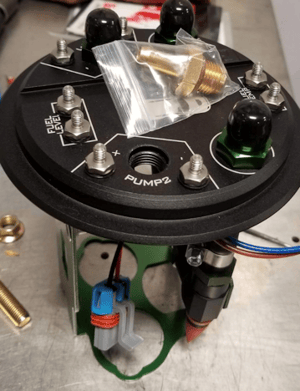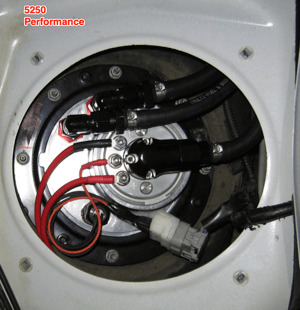 Seeking horsepower Gains? | An often misunderstood engine system is the fuel system.
Seeking horsepower Gains? | An often misunderstood engine system is the fuel system.
Everyone knows that an internal combustion engine runs on fuel, but most people don't know what is really going on inside the cylinder.
The engine sucks in air and mixes it with fuel, then ignites it. But it will only ignite properly if the mixture of air and fuel is just right. Like a good recipe, the ingredients must be right or it won't taste good. The mix of air and fuel in the engine is called the Air-to-Fuel Ratio and is supposed to be 14.7 pounds of air for every pound of gasoline under most driving conditions. When you go full throttle for max power, a richer mixture is desired requiring more fuel.
It's the job of the engine computer to determine how much fuel must be added to the air. As you modify your engine and increase airflow capability, you must also upgrade the fuel system to be able to match. But as with all things, it can be overdone.
The factory fuel system that came with your vehicle is usually designed to flow just slightly more fuel than the engine should ever need. Some cars have a bit more overhead than others and can do more upgrades before needing fuel system upgrades. Other vehicles are so close to maxing out their fuel systems stock, they need upgrades right away.
The fuel system is made up of 4 components. The Fuel Pump, Fuel Injectors, Fuel Lines and Rails, and the Fuel Pressure Regulator.
With all of these components, you should always plan on a little bit larger than you think you need, but don't go too far.  The entire system must be matched and as the capacity goes up, drivability goes down. A fuel system capable of very high fuel flow can be very difficult to control under low engine demands, such as idle and cruise.
The entire system must be matched and as the capacity goes up, drivability goes down. A fuel system capable of very high fuel flow can be very difficult to control under low engine demands, such as idle and cruise.
The fuel pump is one of the first items to be upgraded. When finding a new fuel pump, you will need one that is capable of flowing enough fuel to meet your needs. While you should always plan on a little bit larger than you think you need, it can be overdone. Larger fuel pumps need upgraded wiring to supply them enough power. Upgraded wiring often means the loss of the factory fuel pump speed control, so the pump runs at full speed all the time. This leads to increased pump wear and heating of the fuel. There can also be unintended consequences with the fuel pressure regulator.
The fuel pressure regulator is a device that sets the fuel pressure. All factory regulators are going to be pre-set, commonly at 43.5psi for return style fuel systems and 60psi for return-less.
On boosted engines, the regulator will be vacuum referenced and self adjust as boost goes up and down. A regulator works by bleeding off pressure. An upgraded fuel pump may move so much fuel, the factory regulator cannot bleed off the pressure fast enough. This leads to higher than desired fuel pressures which means the injectors are spraying more fuel than intended.
The consequence is an overly rich air to fuel ratio and a poorly running engine. In the worst examples, the engine may not be able to idle. An aftermarket fuel pressure regulator is capable of much higher fuel volumes and can reliably control the fuel pressure from a very large fuel pump.
Fuel injectors come in many different sizes. It's common to double, triple, and even quadrupole the flow rate of the stock injectors when upgrading. Injectors should be sized to the maximum power output of your engine. The larger an injector gets, the larger it's minimum injection becomes. If the minimum injection is larger than the required amount of fuel, overly rich air to fuel ratio will occur and a poorly running engine will result.
This is why you don't want any larger than you actually need. If you have very high power goals, be prepared to sacrifice drivability. A rough idle and misfires may become your norm.
Connecting everything together are the fuel rails and lines. These are the last fuel system components to be upgraded as the stock lines and rails can often be pushed well beyond stock power levels. The maximum amount of delivered fuel will be determined by the smallest orifice or hose in the fuel system. If you are going for serious power, you will need to make sure everything is enlarged.
This may mean significant modification to the factory fuel tank. Downsides to upgrading the lines and rails are mostly street car concerns. New larger fuel lines may have to be run inside the cabin or under the vehicle. Any fuel system components installed inside the cabin will cause fuel smells. Anything run under the car is susceptible to damage from road debris or bottoming out.



